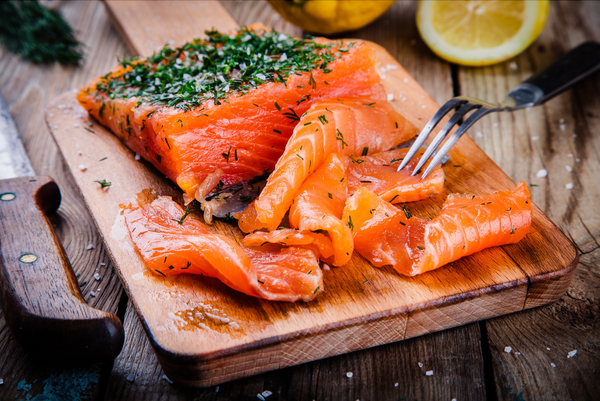How to Make Smoked Salmon at Home
Updated on Jul 06, 2021
Smoked salmon is one of those foods that feels special the moment you taste it. The smoky flavor, tender texture, and rich color make it a favorite for breakfasts, snacks, or even fancy dinners.
You might think it’s something only chefs or stores can make, but the truth is — you can make smoked salmon right in your kitchen. Cold-smoked salmon sounds fancy, but it’s surprisingly simple once you learn the steps. And hot smoking is even easier.
In this guide, you’ll learn everything you need to know — from the tools and ingredients you’ll need, to preparing the fish, to mastering both hot- and cold-smoking techniques.
What is Smoked Salmon?
Smoked salmon is salmon that has been cured with salt and then flavored by smoking it over wood. This process not only gives the fish its signature smoky taste but also helps preserve it. There are two main types of smoked salmon: cold-smoked and hot-smoked.
Cold-smoked salmon is cured and then smoked at a low temperature, which keeps the texture silky and smooth — similar to raw fish.
Hot-smoked salmon, on the other hand, is smoked at a higher temperature, which cooks the fish and gives it a flaky texture, more like baked salmon.
The biggest difference between the two comes down to texture and cooking: cold-smoked salmon stays delicate and raw-like, while hot-smoked salmon is fully cooked and firm.
Related: What’s the Difference Between Nova, Lox, and Smoked Salmon?
What You’ll Need
Before you start smoking salmon, it’s important to gather the right tools and ingredients. Here are the basics you’ll need and why they matter:
- Fresh salmon – The star of the dish. Choose high-quality fillets or sides of salmon for the best flavor and texture.
- Salt (and sometimes sugar) – Used for curing the salmon before smoking. This step seasons the fish and helps draw out excess moisture so it smokes properly.
- Wood chips – These provide the smoky flavor. Different woods (like apple, cherry, or hickory) can give your salmon a slightly different taste.
- Smoker or grill – The tool that creates the smoke and heat. You can use a dedicated smoker for the best results, but a charcoal or gas grill works too with the right setup.
- Cooling rack or tray – After curing, salmon needs to rest so a thin layer, called a pellicle, forms on the surface. This helps the smoke stick better.
With these items in place, you’ll be ready to get started on either hot- or cold-smoking.
Preparing the Salmon for Smoking
Getting your salmon ready is one of the most important steps to ensure great flavor and texture. Start by choosing the right cut: a fillet or a whole side of salmon. Fillets are easier to handle and smoke more quickly, while a whole side can give you a larger, show-stopping piece that’s perfect for serving guests.
Once you’ve selected your cut, trim away any uneven edges and carefully remove the pin bones with tweezers or clean pliers — this makes the finished product easier to slice and eat.
Next, you’ll need to cure the salmon, which can be done with either a brine or a dry cure.
A brine involves soaking the fish in a salt-and-water solution, sometimes with sugar and spices added for extra flavor. A dry cure, on the other hand, is made by rubbing a mixture of salt, sugar, and seasonings directly onto the salmon. Both methods help season the fish and draw out moisture so it can absorb the smoky flavor more effectively.
For best results, allow the salmon to cure in the refrigerator for 8–12 hours for fillets or up to 24–48 hours for a whole side, depending on its thickness.
After curing, rinse off the excess salt, pat the salmon dry, and let it rest uncovered in the fridge so a slightly tacky surface (called the pellicle) forms. This step helps the smoke cling beautifully to the fish.
How to Make Smoked Salmon
Once your salmon is cured and ready, the next step is smoking. Smoking is what gives the fish its deep flavor, beautiful color, and unique texture. Both hot-smoking and cold-smoking are simple once you understand the steps, and each produces a slightly different result.
How to Hot-Smoke Salmon
Hot-smoking is the easiest way to get started because it both flavors and cooks the salmon at the same time. The result is moist, flaky fish that you can serve warm or cold.
Here are the steps for hot-smoking salmon:
- Preheat your smoker or grill – Set it up for indirect heat at around 225°F (107°C). Add wood chips to create smoke.
- Place the salmon on a rack – Make sure the skin side is down, and leave space between pieces so the smoke can circulate.
- Smoke the salmon – Close the lid and let it smoke until the fish reaches an internal temperature of 145°F (63°C). This usually takes 1–3 hours, depending on thickness.
- Rest and cool – Remove the salmon and let it cool slightly. You can eat it warm or refrigerate it for later.
How to Cold-Smoke Salmon
Cold-smoked salmon takes more patience, but the result is a smooth, melt-in-your-mouth fish that feels extra special. Unlike hot-smoking, cold-smoking doesn’t actually cook the fish, so the curing step is very important for food safety.
Here are the steps for cold-smoking salmon:
- Cure and dry the salmon – Make sure the fish has been properly cured (8–48 hours depending on thickness) and allowed to dry until the surface is slightly tacky.
- Prepare your smoker – Keep the temperature very low, ideally below 80°F (27°C). You’ll need a cold smoke generator or a way to keep the heat source separate so it doesn’t cook the fish.
- Smoke the salmon slowly – Place the fish on the rack and let it absorb smoke for 6–24 hours, depending on how strong you want the flavor.
- Rest and chill – After smoking, wrap the salmon tightly and refrigerate it for at least a few hours to let the flavors develop.
Related: Is Smoked Salmon Cooked or Raw?
Kyle’s Tips for Success
I’ve smoked a lot of salmon at home, and along the way I’ve learned what works (and what doesn’t). These are the tips I rely on for the best outcome:
- Be patient with the cure: I know it’s tempting to rush, but curing the salmon fully is key to flavor and texture. When I first started, I cut the curing time short, and the fish turned out bland. Give it the full time your cut needs, and you’ll taste the difference.
- Let the salmon form a good pellicle: This thin, sticky layer on the surface is what grabs onto the smoke. I always make sure the fish rests uncovered in the fridge until it feels tacky. Skipping this step can make your salmon taste flat instead of smoky.
- Choose your wood carefully: The type of wood chips you use really changes the flavor. I prefer fruit woods like apple or cherry for a lighter, slightly sweet taste. If you want something bolder, go with alder or hickory — but be careful not to overdo it, or the smoke can overpower the salmon.
How to Store Smoked Salmon
Proper storage is key to keeping your smoked salmon fresh and safe to eat. If you plan to enjoy it within a week, refrigeration is the best option. Place the salmon in an airtight container or wrap it tightly in plastic wrap and foil to prevent it from drying out or absorbing other flavors in the fridge.
For longer storage, freezing works well. Wrap the salmon securely in plastic wrap, then place it in a freezer bag to help lock in freshness.
Homemade smoked salmon generally lasts about 5–7 days in the refrigerator or up to 2–3 months in the freezer when stored properly.
If you want to maximize its shelf life, vacuum-sealing is a smart choice. Removing the air around the salmon helps prevent freezer burn and can extend freshness to 6 months or more in the freezer.
Whether refrigerated or frozen, always label your salmon with the date you made it so you can keep track of how long it’s been stored.
Mistakes to Avoid
When smoking salmon, a few common mistakes can affect both flavor and texture. Over-salting or under-curing is one of them — too much salt will make the fish unpleasantly briny, while not curing long enough can leave it lacking flavor and preservation.
Another mistake is using too much smoke, which can overpower the salmon’s natural taste and leave a bitter aftertaste instead of a balanced, delicate flavor.
Finally, not monitoring temperature closely can ruin your efforts; temperatures that are too high can dry out the fish, while temperatures that are too low during hot smoking may prevent it from cooking properly.
Careful attention to these details ensures a perfectly smoked salmon every time.
BONUS: How to Make Smoked Salmon Dip
If you have leftovers or want to try something different, smoked salmon dip is an easy and tasty way to use your fish.
Start with about 1 cup of flaked smoked salmon. Mix it with 8 ounces of softened cream cheese, 2–3 tablespoons of sour cream or Greek yogurt, and a squeeze of fresh lemon juice.
Add chopped fresh dill, green onions, or capers for extra flavor. Blend until smooth or leave it a little chunky for texture.
This dip is perfect with crackers, toasted bread, or fresh veggies and makes a quick appetizer that shows off your homemade smoked salmon!
Summary
Making smoked salmon at home is easier than most people think. With just a few tools, some patience, and the right steps, you can create salmon that’s smoky, flavorful, and fresher than anything from the store. Hot-smoking gives you tender, flaky salmon ready in just a few hours, while cold-smoking delivers a silky, delicate texture perfect for bagels or appetizers.
Start with the best! Our sustainably caught Wild King Salmon and Wild Sockeye Salmon. Their superior quality ensures your homemade smoked salmon is both delicious and responsibly sourced.
FAQs
Is it cheaper to make your own smoked salmon?
Yes. Store-bought smoked salmon can be pricey, while making it at home is usually more affordable, especially if you buy salmon fillets in bulk.
How long does it take to smoke salmon?
For hot-smoking, it usually takes 1–3 hours, depending on the thickness. Cold-smoking takes longer, often 6–24 hours, but it creates a different texture.
Can you smoke salmon without brining?
It’s not recommended. Brining or curing is essential to add flavor, draw out moisture, and make the salmon safe to smoke. Skipping this step can result in bland and unsafe fish.
How long will homemade smoked salmon last?
In the refrigerator, smoked salmon lasts about 5–7 days. If frozen and properly sealed, it can last 2–3 months, or up to 6 months if vacuum-sealed.







